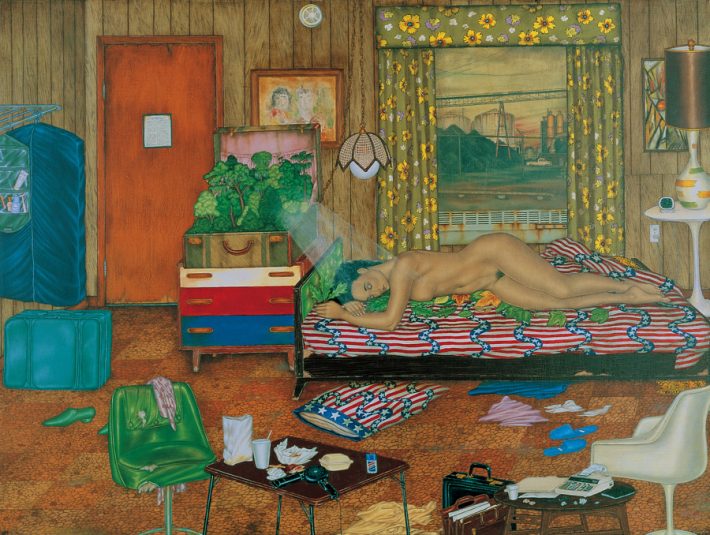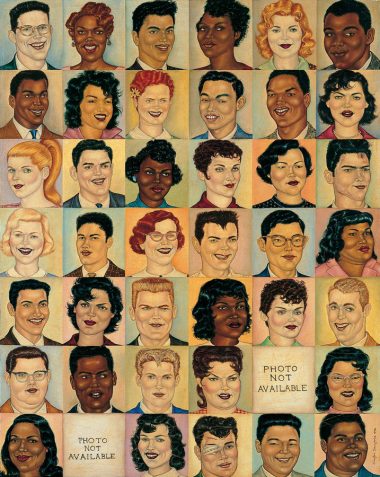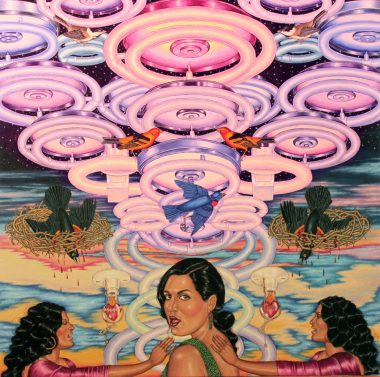via The Iron Lattice, Volume 3
Douglas Bourgeois, Iko Ikon, 2010
In spite of his relative seclusion in rural Louisiana, Douglas Bourgeois never wants for inspiration. On almost every inch of wall space in his simple cottage in St. Amant hangs the artwork of his friends and contemporaries. His art studio, lined with orderly shelves of assorted objets, could double as a curio shop. His curiosity lies at the heart of his creative vitality; the bold colors and elaborate and peculiar details of his paintings indicate a man who is dazzled by the world around him. This sense of awe speaks to the artist within each of his viewers. For Douglas Bourgeois, art is something everyone can know; it belongs to anyone with an eye for the spectacular. “Art is an open secret,” as he puts it, though it must be said that no one tells the secret quite like he does.
Let’s start at the beginning. Did you always want to be an artist?
When I was young, I was as an altar boy. I went to mass everyday and I was even on my way to being a priest. Some of the earliest art I ever saw was in churches and in the missiles, the prayer book for mass, which had all these reproductions of Renaissance paintings. Boticelli, Da Vinci, Goya… In the Sacred Heart Catholic Church in Baton Rouge there is a giant Byzantine narrow skeletal looking thing over the apse (it was Jesus over the cross). When I was a little kid, I thought it was going to come to life any minute. There were also these paintings of a Lazarus risen from the dead looking just like David Bowie. I mean, they were just the wildest paintings I’d seen.
How did you come to be a painter?
I graduated to find that I am not really qualified to do any other job. I was a file clerk, a waiter, just meandering through it all. But even when I was a file clerk, I would come home and paint for four hours, and even on the weekends I would paint all Saturday and Sunday. It was something in me. One day I decided to get serious, and I was disciplined for a while until I moved to New Orleans…
So New Orleans was a bit of a distraction then?
Oh, please! The alcohol, the 24-hour bars! And even though I’d stopped smoking years ago, the minute I would cross the parish line… At some point, I decided to move back to Saint Amant to see if I could isolate myself and that’s what I did. At the beginning of your career in the 80s, how was your art received? My art always appealed more to ordinary people than the academics. Storytelling will always reach anyone—you know that saying, art is an open secret? The human figure was in most of the work, and that may seem basic, but every now and then you have to reinvent how you show the human figure. The critics would refer to the art work as “illustration” or whatever. Conceptualism had sort of an academic superiority complex.

Douglas Bourgeois, The Traveler, 1993
How do you see the figures in your paintings?
I guess I call them everypersons. They stand in for all these anonymous people. It’s like you’re telling a story and these characters are the lead, the main characters of a short story. There’s one called The Traveler. She’s a traveling salesperson or whatever in this horrible hotel room. That’s where you really get to build a story with all these little details. I almost think sometimes I put too much stuff in them. There’s something they call horror vacui, which means fear of empty space. Her calculator, her briefcase, her hair dryer and her fast food. She’s perfectly nude with leaves under the bed, and she’s opened her suitcase and this little tiny forest with these rays coming off it heal her. Outside is a chemical plant, which I got from driving along a river. How many rec rooms have you been in with this paneling? The orange door… it’s just part of the part of the costume. One time somebody asked me why do you put current groceries and things in the painting? It’s so you don’t think it’s a painting from long ago. It’s to place it in time like a photographer does. It’s hazy, time indeterminate, but within a range of time that is late American consumer culture.
Can you delve into the southern Louisiana atmosphere for us?
It’s really complex: the climate, the overabundance of greenery. It’s so extreme here because it’s so wet and the foliage is very specific. Then there’s the history of New Orleans with the different countries that took it over, bought it and sold it. And then the nexus of slavery. We are one of the poorest states in the nation. The music and food, it comes from poverty, having nothing. You just took whatever vegetables were available and cooked from that, or made music with handmade instruments.

Douglas Bourgeois, Nightflame, 1988
Would you say global cultural centers make it hard to feel relevant as a regional artist?
You don’t need the Good Housekeeping Seal of Approval from other arts centers. And actually, around the world, regionalism or regional distinctions in art are more encouraged now just like indigenous works or tribal art. It used to be like, “Well, you have to go back and study some more because this is primitive!” Now it’s like, “Oh yes, this is primitive! Yay!”
What do you think is precipitating the change?
In a certain way, the New York scene is less unattainable. It’s not so much that the grass is always greener. Now you’re like, “Well, why bother?” Not everybody wants to be a blue chip art star. I just want to make enough to keep doing what I do. I see more of this now in New Orleans, where you just bring your stuff to a space to have a one-day show. To be an artist in this time, I think it is hard particularly because your identity is watered down by the multitude of avenues you have available to you. We have to use the Internet, but we also have to put on the blinders at times.
How do you balance hearing feedback without letting criticism get you down?
One time I received really discouraging feedback. These people said there’s no development in my paintings. For some reason, I just really let it get to me and my friend was like, “Well, sometimes the process of art is not comfortable.” She was saying, don’t expect to be patted on the back all the time. Maybe I got dependent on positive feedback for my work. I like the saying, “Do not become dependent on the good opinion of others.”

Douglas Bourgeois, Lacrima Christi High School Seniors ’56, 1996
One last thing. Could you touch on your ongoing yearbook series?
What I like about yearbooks is this innocence about people before they get all their dreams crushed. I tried in this series to do more people that were not perfect physically. Some people think they’re caricatures, but really I’m trying to just push that expression, just a little more twisted. That’s what’s so great about yearbooks; it’s not a magazine, it’s every kind of person in the world, unfiltered. I rename them to protect the innocent. Hah.

Douglas Bourgeois, Double Holy Spirit Coco, 2013
